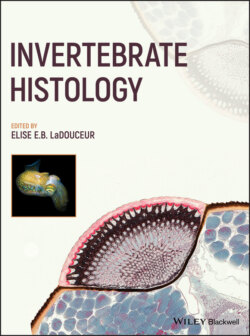Читать книгу Invertebrate Histology - Группа авторов - Страница 25
1.3.10 Special Senses
ОглавлениеIn echinoderms, the integument including all appendages could be considered a sensory organ due to the presence of neurosensory cells throughout the epidermis. These cells are particularly concentrated on the surface of discs of the podia, at the bases of the spines and pedicellariae, along the margins of the ambulacral grooves and at the tips of the terminal tentacles and likely provide light, tactile, and chemical reception (Ruppert et al. 2004). All of these receptors connect with the subepidermal superficial nerve net mentioned previously. The primary defined sensory organs in asteroids are eyespots and sensory tube feet (previously described). Eyespots consist of ocelli, each of which is formed by a cup of epidermal cells containing red pigment filled with receptor cells. The receptor cells are connected to the radial nerve cord at the base of the sensory terminal tentacle on the oral side of each arm. The cuticle is thickened in these areas, ultimately focusing light onto the receptors like a lens (Leake 1975). Specialized sense organs are absent in Ophiuroidea. Sphaeridia are minute appendages in the ambulacral regions of noncidaroid echinoids that are thought to be equilibratory organs. Histologically, sphaeridia consist of a spherical solid (nonmeshed) ossicle covered in ciliated epidermis, and attached to a tubercle by a muscle sheath and thin band of connective tissue (Cavey and Märkel 1994). Within Holothuroidea, burrowing members of Apodida have a single statocyst adjacent to each radial nerve at the junction of the nerve with the calcareous ring. Some Apodida also have an eyespot at the base of each tentacle (Ruppert et al. 2004).
